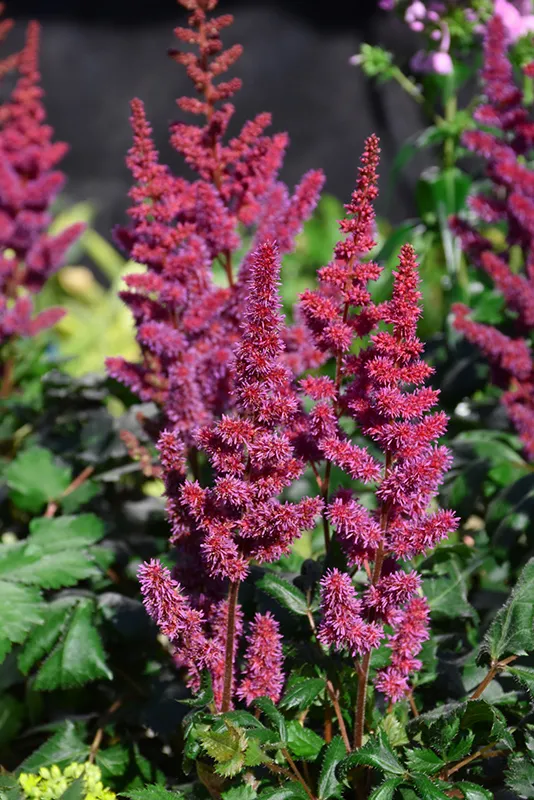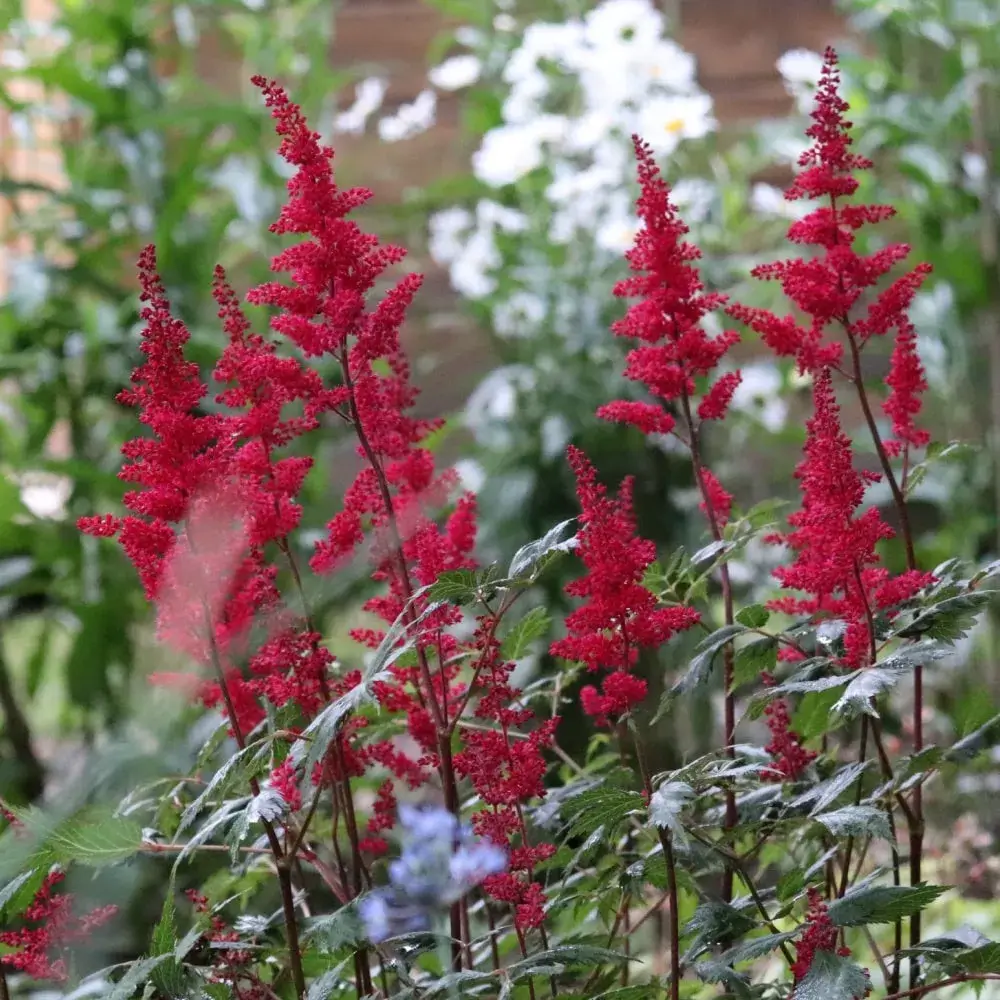Family: Astilbe
Type: Perennial
Other Common Name: False Spirea

Visions in Red Astilbe stands out with its vibrant, feathery plumes and lush, fern-like foliage. This perennial is known for its striking red blooms and resilience, making it a garden favorite.
Visions in Red Astilbe thrives in partial to full shade, preferring moist, well-drained soil. Its vivid red flowers bloom in mid to late summer, adding a splash of color to shady garden spots.
Hardiness Zone: 2b-9a
Deer Resistant: Yes
Pet Friendly: Yes
Moisture Preference: Moist
Sun Needs: Partial shade to shade
Growth Rate: Medium
Average Height (feet): 2
Average Spread (feet): 1.5
Average Life Span (years): 10
Form: Upright spreading
Flower Color: Red
Bloom Season: In early summer
Foliage Color: Green
Foliage Shape: Ferny
Incorporating Visions in Red Astilbe into your landscape can create a stunning visual contrast. Its bright red blooms pair well with green foliage plants.
This plant’s compact size makes it ideal for borders or as a focal point in small garden spaces. It’s also great for adding depth and interest to shaded areas where color is often limited.

In a cottage garden setting, Visions in Red Astilbe adds a romantic touch with its feathery, bright red blooms. It complements traditional cottage garden plants like roses and lavender, creating a charming, whimsical feel.
In woodland gardens, this Astilbe's shade tolerance and fern-like leaves blend seamlessly with native ferns and shade-loving perennials. Its red blooms provide a striking contrast against the predominantly green backdrop.
Visions in Red Astilbe is well-suited for rain gardens. Its preference for moist conditions and striking appearance enhance the natural, fluid design of a rain garden, contributing both aesthetic and ecological value.
Grouping multiple Visions in Red Astilbe plants can create a dramatic display of color. Their feathery blooms add texture and depth to garden beds.
Pairing this Astilbe with plants that have contrasting foliage or bloom colors can highlight its unique features. Think hostas or silver-leaved perennials for a stunning contrast.
Incorporate Visions in Red Astilbe into a shaded rock garden for an unexpected pop of color. Their bright blooms can liven up typically green and gray rock garden landscapes.
Select our pre-made garden layouts to create a landscape that’s uniquely yours. Simple, smart, and customizable!
In spring, Visions in Red Astilbe starts to show its lush, green foliage, setting the stage for the summer blooms. This period of fresh growth brings life to the garden after winter.
Summer is when Visions in Red Astilbe truly shines. Its vibrant red plumes stand tall above the foliage, creating a striking display that lasts through the season.
As fall approaches, the flowers of Visions in Red Astilbe fade, but its foliage remains robust, adding green texture to the autumn garden. It's a graceful transition into the cooler months.
During winter, Visions in Red Astilbe becomes dormant. The foliage may persist in milder climates, adding structure to the winter garden, but in colder areas, it will die back until spring.
Hydrangea paniculata 'Phantom'
Hosta 'Patriot'
Athyrium Nippocum 'Pictum'
Visions in Red Astilbe thrives in areas with partial to full shade. Ideal spots are under trees, on the north side of buildings, or in any space that doesn’t receive harsh afternoon sun. This plant loves a bit of shelter from the heat.
While it needs some light to bloom, Visions in Red Astilbe should avoid direct sunlight, especially in hot climates. Morning sun and afternoon shade are ideal conditions for this shade-loving perennial.
Astilbe prefers rich, moist, and well-draining soil. Amending your garden soil with organic matter like compost can improve soil fertility and moisture retention, which is crucial for healthy Astilbe growth.
Plant Visions in Red Astilbe about 18 to 24 inches apart. This spacing allows for ample air circulation, reducing the risk of fungal diseases while providing enough room for each plant to reach its full size.
The best time to plant Visions in Red Astilbe is in the spring or early fall. Planting during these cooler months allows the roots to establish before the extremes of summer heat or winter cold.
Dig a hole as deep as the root ball and twice as wide. Place the plant in the hole, fill with soil, and water thoroughly. Mulching around the base can help retain moisture and regulate soil temperature.
Regular watering is key, especially during dry spells. Visions in Red Astilbe prefers consistently moist soil. Overwatering can lead to root rot, so ensure good drainage.
Feed Visions in Red Astilbe in early spring with a balanced, slow-release fertilizer. This extra nutrient boost supports lush foliage and vibrant blooms.
Deadhead spent blooms to encourage more flowering. Cut back the foliage in late fall or early winter after it dies back.
Early spring is the time to remove any old, dead foliage and apply mulch. This is also when you should apply fertilizer to support new growth.
During summer, ensure consistent watering, especially in periods of drought. Mulch helps retain soil moisture and keep the roots cool.
In fall, you can divide and replant overcrowded clumps to maintain plant health. Reduce watering as the plant prepares for dormancy.
Visions in Red Astilbe is hardy but benefits from a protective layer of mulch in winter. This helps insulate the roots against freezing temperatures.
Astilbe chinensis 'Visions in pink'
Astilbe arendsii 'Fanal'
Astilbe Chinensis 'Visions In White'
Typically, the blooms last for several weeks in mid to late summer. Deadheading spent flowers can sometimes encourage a second, though less vigorous, bloom.
It’s not ideal. Visions in Red Astilbe can tolerate morning sun but needs protection from strong afternoon sun to prevent leaf burn and stress.
Yes, Visions in Red Astilbe is generally deer resistant. Its texture and taste are not appealing to deer, making it a good choice for gardens in areas with deer activity.
Sign up below to get exclusive deals, discounts, and new plant collections—delivered straight to your inbox! Plus, stay inspired with the latest gardening tips, landscaping trends, and DIY garden ideas. Start growing with us today!
A big thank you for subscribing to the PBN Design newsletter.
We're thrilled to have you join our community. Get ready for exciting updates, insightful content, and more delivered straight to your inbox.
Stay tuned!
Go backA big thank you for subscribing to the PBN Design newsletter.
We're thrilled to have you join our community. Get ready for exciting updates, insightful content, and more delivered straight to your inbox.
Stay tuned!
Go back